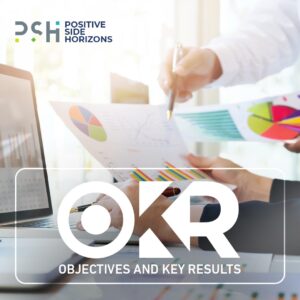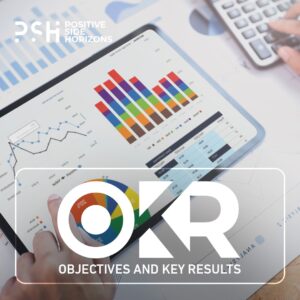At a time of fast-paced advancements and developments, business owners have to resort to means that allow them to stay on top of everything new, be fully prepared to respond quickly to contemporary changes, and do away with old plans and goals that fail to consider the rapidly evolving business landscape. For all of this, the world was introduced to the concept of Objectives and Key Results “OKRs” to help achieve companies’ objectives. But what are OKRs? And what are the steps for creating and implementing that methodology?
Since joining Kleiner Perkins in 1980, venture capitalist John Doerr has helped fund many large companies, such as Intuit, Twitter, Google, Amazon, and other well-known tech companies. The reason he invested in these companies was that they followed the OKRs methodology. He published a book called Measure What Matters containing his explanation for how and why that methodology works. When asked about why he published this book, he said, “In the mid-1970s, I got a job at Intel. It was a very vibrant time in the company’s life. They had just invented the microchip, which became the basis of the personal computer. I got to be a student of Andy Grove, one of the greatest managers of his, or any other, era. Andy had created this system for goal setting that was deceptively simple, but also the polar opposite of the conventional management by objectives (MBO) systems (developed by Peter Drucker, the Father of Management)”.
John believes that objective is what one wants to accomplish, and key results are how to get this objective done. The objectives are typically longer lived. They’re bold and aspirational. The key results have to do with struggling and striving toward the fulfillment of objectives, but they’re always measurable and time-bound.
In this regard, one of the powerful things about this system is that at any level of a company or organization you can have two or three, or maybe four, objectives, and three or four key results for each objective. So it requires a kind of rigor and discipline about saying, these are the most important things that are going on in a company or organization.
4 Steps for Creating and Implementing OKRs:
Now that we know what OKRs are, here are four steps to properly create and implement OKRs:
-
Prepare
One of the most overlooked yet most important phases in creating OKRs is the preparation phase. Setting new OKRs requires proper preparation even before sitting down and listing Objectives.
One of the most important things to prepare for is researching what the company or organization needs, and what it has learned from past experiences, accomplishments, and challenges. It is usually up to the company or team leadership to research and reflect on past reports, documents, and references to better grasp long-term strategic goals. Preparation, of course, takes time, as proper planning requires also proper preparation. Therefore, it is essential to dedicate enough time to prepare before the actual formation of OKRs.
-
Brainstorm
Once the preparation and research phase is done and the company’s actual and basic needs and long-term goals are set and grasped, leaders can set up a designated time and place for writing and formulating their reports and key results. In this phase, it is essential to get the right people involved in setting up your team and company’s goals.
Know who are “the relevant players in the planning process in your company or organization” and what insight they can bring to the table for the people involved in goal setting. It is also essential to invite various people from different cultures and experiences to get a holistic perspective on all goals.
If you are handling various departments, also make sure that each department is well represented in the meeting. It will ensure that your key results will be realistic and inclusive for all. Also, allot ample time before the meeting so participants can prepare their ideas and proposals for the goal-setting activity.
On the day of the meeting, create an environment that is open to discussion and propositions. Allow everyone to speak and listen. The first step is to determining how many objectives you need for a given time frame. For example, you can decide that you need three main objectives for the next three months. Once you have decided on that, draft the actual objectives for those three months. Keep in mind the characteristics of objectives as earlier discussed, such as aspirational, realistic, and grounded in the company’s overall goals.
Here are some examples of real objectives set by some of the world’s biggest companies:
- YouTube: – Reach 1 billion hours of watch time per day by 2016.
- Google: – We should make the web as fast as flipping through a magazine.
- MyFitnessPal: – Help more people around the world.
- The Gates Foundation: – Global eradication of Malaria by 2040.
It is also important to know the company’s capacity and the staff’s competencies in creating objectives. Objectives must be ambitious to push the team to their potential and be grounded in reality to be achievable.
Once you have an actual working objective, you can move on to craft key results. Just as with objectives, you can refer to valuable sources such as earlier company reports, annual reports, performance metrics, staff performance and capacities, and other existing indicators. These past reports are vital so that you can have a baseline on where to start. They can also help you determine the team’s strengths, weaknesses, capacities, and areas of improvement.
Aside from the internal capacities of your team or company, an important point of discussion for OKRs is external factors. You can keep your good performance rates in check by asking questions such as:
- Is this possible given the current situation of the company?
- Are these OKRs aligned with the overall direction of the company 3 to 5 years from now?
- Are there other unaccounted external threats that could make achieving these key results impossible?
- Is it wise to pursue these objectives, especially considering other competitors’ track records, or should you focus your energies elsewhere?
Another thing to consider is your time frame. Companies usually set standard time frames such as monthly, quarterly, semi-annually, or annually. Setting time frames is vital to creating accountability for the staff.
-
Designate
In designating tasks for the team, emphasize that each objective is a common goal for everyone. It will be more efficient and motivating for the team to designate each individual or team to a specific key result, rather than having one objective per individual or team.
For example, you have three objectives for the next quarter, and each of those objectives has four key results. Instead of assigning one entire objective and a whole set of key results to one team and have them do everything on that particular goal, scatter the key results to various teams or individuals. This way, the whole team can create a collaborative environment that is conducive to motivation and progress.
In this stage, it is also important to know your team’s strengths, weaknesses, capabilities, and limits to efficiently designate each key result to the right group of people.
-
Align and Track
Once everything is in place—objectives and key results are determined, and tasks are designated—everything is expected to roll out naturally.
You can do this by conducting constant monitoring and opening your lines of communication to your team. It would be best if you kept the OKR progress board open to the public for transparency and team motivation.
To align and track your team’s progress, you can either conduct periodic group meetings to check progress or one-on-one sessions for updates. Whatever mechanism you use, make sure that it delivers the goal of capturing your team’s progress, knowing how they feel about the goals, and ensuring that the staff has not lost sight of what they should be doing and what they should work toward.





